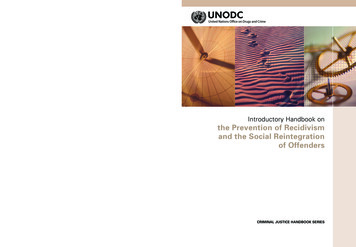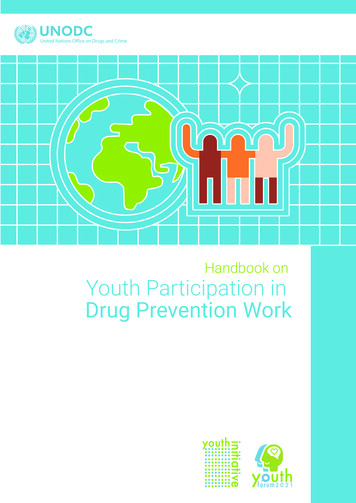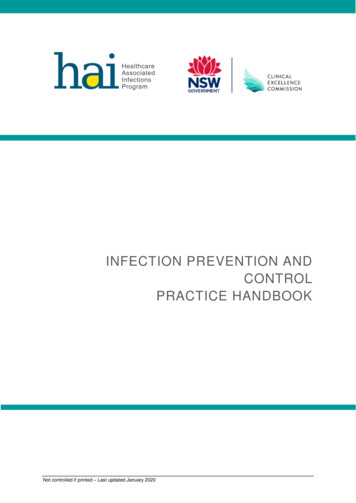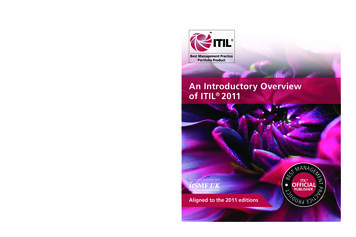
Transcription
Vienna International Centre, PO Box 500, 1400 Vienna, AustriaTel: ( 43-1) 26060-0, Fax: ( 43-1) 26060-5866, www.unodc.orgIntroductory Handbook onthe Prevention of Recidivismand the Social Reintegrationof OffendersUnited Nations publicationPrinted in Austria*1255107*V.12-55107—December 2012—400CRIMINAL JUSTICE HANDBOOK SERIES
Cover images: Left and right: Photodisc.com, Centre: iStockphoto.com/theprint
UNITED NATIONS OFFICE ON DRUGS AND CRIMEViennaIntroductory Handbook onthe Prevention of Recidivism andthe Social Reintegration of OffendersCRIMINAL JUSTICE HANDBOOK SERIESUNITED NATIONSNew York, 2012
United Nations, December 2012. All rights reserved.The designations employed and the presentation of material in this publication donot imply the expression of any opinion whatsoever on the part of the Secretariatof the United Nations concerning the legal status of any country, territory, city orarea, or of its authorities, or concerning the delimitation of its frontiers orboundaries.Publishing production: English, Publishing and Library Section, United NationsOffice at Vienna.
AcknowledgementsThe Introductory Handbook on the Prevention of Recidivism and the Social Reintegrationof Offenders has been prepared for the United Nations Office on Drugs and Crime(UNODC) by Vivienne Chin, Associate of the International Centre for Criminal LawReform and Criminal Justice Policy, Canada, and Yvon Dandurand, criminologist atthe University of the Fraser Valley, Canada.A first draft of the Introductory Handbook was reviewed and discussed during anexpert group meeting held in Vienna on 16 and 17 November 2011. UNODC wishesto acknowledge the valuable suggestions and contributions of the following expertswho participated in that meeting: Charles Robert Allen, Ibrahim Hasan Almarooqi,Sultan Mohamed Alniyadi, Tomris Atabay, Karin Bruckmüller, Elias Carranza, ElinorWanyama Chemonges, Kimmett Edgar, Aida Escobar, Angela Evans, José Filho,Isabel Hight, Andrea King-Wessels, Rita Susana Maxera, Marina Menezes, HugoMorales, Omar Nashabe, Michael Platzer, Roberto Santana, Guy Schmit, VictoriaSergeyeva, Zhang Xiaohua and Zhao Linna.The following UNODC staff also contributed to the development of the IntroductoryHandbook: Piera Barzano, Estela Máris Deon, Fabienne Hariga, Valérie Lebaux, Alexandra Martins, Philipp Meissner, Anna Giudice Saget and Miri Sharon.UNODC gratefully acknowledges the funding provided by the Department of ForeignAffairs and International Trade, Canada, for the development, printing anddissemination of the Introductory Handbook and its translation into French and Spanish.iii
This Introductory Handbook on the Prevention of Recidivism and the SocialReintegration of Offenders is dedicated to prison and probation staff as well as serviceproviders and volunteers working with prisoners and ex-prisoners around the world.v
Contents PageAcknowledgments. . . . . . . . . . . . . . . . . . . . . . . . . . . . . . . . . . . . . . . . . . . . . . . . . . iiiI. Introduction . . . . . . . . . . . . . . . . . . . . . . . . . . . . . . . . . . . . . . . . . . . . . . . . . . 1II. Why invest in the social reintegration of offenders. . . . . . . . . . . . . . . . . . . . . 5A. What is social (re)integration? . . . . . . . . . . . . . . . . . . . . . . . . . . . . . . . . . 5B. The importance of reintegration programmes . . . . . . . . . . . . . . . . . . . . . 7C. Desistance from crime and the prevention of recidivism . . . . . . . . . . . . 9D. Addressing risk factors. . . . . . . . . . . . . . . . . . . . . . . . . . . . . . . . . . . . . . 10E. Reintegration programmes and the criminal justice system. . . . . . . . . . 12F. International standards. . . . . . . . . . . . . . . . . . . . . . . . . . . . . . . . . . . . . . 13III. Implementing succcessful reintegration programmes . . . . . . . . . . . . . . . . . . 17A. Developing a reintegration strategy . . . . . . . . . . . . . . . . . . . . . . . . . . . . 17B. Programme development . . . . . . . . . . . . . . . . . . . . . . . . . . . . . . . . . . . . 23C. Programme monitoring and evaluation . . . . . . . . . . . . . . . . . . . . . . . . . 27IV. Reintegration programmes in prisons. . . . . . . . . . . . . . . . . . . . . . . . . . . . . . 31A. International standards. . . . . . . . . . . . . . . . . . . . . . . . . . . . . . . . . . . . . . 32B. Offender assessments . . . . . . . . . . . . . . . . . . . . . . . . . . . . . . . . . . . . . . 36C. Programming in prison . . . . . . . . . . . . . . . . . . . . . . . . . . . . . . . . . . . . . 39D. Pre-release programmes. . . . . . . . . . . . . . . . . . . . . . . . . . . . . . . . . . . . . 52E. Halfway houses and transition centres. . . . . . . . . . . . . . . . . . . . . . . . . . 61V. Post-release reintegration and aftercare programme. . . . . . . . . . . . . . . . . . . 63A. International standards . . . . . . . . . . . . . . . . . . . . . . . . . . . . . . . . . . . . . 65B. Aftercare and re-entry assistance . . . . . . . . . . . . . . . . . . . . . . . . . . . . . . 68C. Offender supervision . . . . . . . . . . . . . . . . . . . . . . . . . . . . . . . . . . . . . . . 73D. Early release programmes. . . . . . . . . . . . . . . . . . . . . . . . . . . . . . . . . . . 77E. The role of the community . . . . . . . . . . . . . . . . . . . . . . . . . . . . . . . . . . 80vii
VI. Non-custodial social integration interventions. . . . . . . . . . . . . . . . . . . . . . 87A. International standards: non-custodial interventions . . . . . . . . . . . . . 88B. Non-custodial sanctions and the social integration of offenders . . . . 89C. Probation and community supervision. . . . . . . . . . . . . . . . . . . . . . . . 91D. Community service. . . . . . . . . . . . . . . . . . . . . . . . . . . . . . . . . . . . . . . 97E. Social reintegration through diversion programmes . . . . . . . . . . . . . . 99F. Restorative justice and social reintegration . . . . . . . . . . . . . . . . . . . . 101VII. Reintegration programmes for child offenders. . . . . . . . . . . . . . . . . . . . . 103A. International standards . . . . . . . . . . . . . . . . . . . . . . . . . . . . . . . . . . . 104B. Assessment. . . . . . . . . . . . . . . . . . . . . . . . . . . . . . . . . . . . . . . . . . . . . 108C. Diversion. . . . . . . . . . . . . . . . . . . . . . . . . . . . . . . . . . . . . . . . . . . . . . 108D. Community-based measures . . . . . . . . . . . . . . . . . . . . . . . . . . . . . . . 110E. Custodial programmes for child offenders . . . . . . . . . . . . . . . . . . . . 110F. Early or conditional release. . . . . . . . . . . . . . . . . . . . . . . . . . . . . . . . 112G. Post-release interventions and aftercare. . . . . . . . . . . . . . . . . . . . . . . 112VIII. Reintegration programmes for women offenders. . . . . . . . . . . . . . . . . . . 119A. International standards . . . . . . . . . . . . . . . . . . . . . . . . . . . . . . . . . . . 120B. Gender-sensitive programmes . . . . . . . . . . . . . . . . . . . . . . . . . . . . . . 121C. Release planning and post-release support . . . . . . . . . . . . . . . . . . . . 125IX. Reintegration programmes for specific groups of offenders. . . . . . . . . . . 129A. Mentally ill offenders . . . . . . . . . . . . . . . . . . . . . . . . . . . . . . . . . . . . 130B. Drug-dependent offenders. . . . . . . . . . . . . . . . . . . . . . . . . . . . . . . . . 132C. Elderly offenders. . . . . . . . . . . . . . . . . . . . . . . . . . . . . . . . . . . . . . . . 132D. Foreign nationals. . . . . . . . . . . . . . . . . . . . . . . . . . . . . . . . . . . . . . . . 134E. Members of ethnic or racial minorities and indigenous peoples. . . . 136F. Members of gangs and criminal groups . . . . . . . . . . . . . . . . . . . . . . 138G. Violent offenders. . . . . . . . . . . . . . . . . . . . . . . . . . . . . . . . . . . . . . . . 138H. Sexual offenders . . . . . . . . . . . . . . . . . . . . . . . . . . . . . . . . . . . . . . . . 139I.Prisoners with physical disabilities. . . . . . . . . . . . . . . . . . . . . . . . . . . 141J.Prisoners with learning disabilities and difficulties . . . . . . . . . . . . . . 142K. Prisoners with HIV/AIDS. . . . . . . . . . . . . . . . . . . . . . . . . . . . . . . . . 143L. Prisoners released after extended pretrial detention. . . . . . . . . . . . . 144AnnexesI.Glossary of terms . . . . . . . . . . . . . . . . . . . . . . . . . . . . . . . . . . . . . . . 149II. Bibliography . . . . . . . . . . . . . . . . . . . . . . . . . . . . . . . . . . . . . . . . . . . 151viii
I.IntroductionThe present Introductory Handbook on the Prevention of Recidivism and the SocialReintegration of Offenders is part of a series of practical tools developed by the UnitedNations Office on Drugs and Crime (UNODC) to support countries in preventingcrime, implementing criminal justice reforms and strengthening the rule of law. Thesetools are meant to assist them in implementing United Nations standards and normsin crime prevention and criminal justice.1 The Introductory Handbook emphasizes thecrucial importance of effective programmes and measures to supervise and assistoffenders and support their social reintegration for the prevention of recidivism.Incarcerated offenders face some very real challenges at the time of their release,and communities become unsafe when offenders with high risk and needs are releasedwithout adequate preparation, supervision or support.No crime prevention strategy is complete without effective measures to address theproblem of recidivism. A comprehensive strategy must obviously take into accountthe fact that public safety is affected by the large number of crimes committed byindividuals who have already faced criminal sanctions but have not yet desisted fromcrime. Without effective interventions, reoffending remains likely. Many offenders,even after a term of imprisonment, fail to reintegrate into the community as lawabiding citizens. This is why effective social integration or reintegration programmesare urgently required. They are essential means of preventing recidivism and increasing public safety, two very important social policy objectives in all countries.International standards and norms reaffirm that the rehabilitation of offenders andtheir successful reintegration into the community are among the basic objectives ofthe criminal justice process. In so doing, they emphasize the importance of interventions to support the reintegration of offenders as a means to prevent further crimeand protect society. In fact, adopting measures to ensure the effective reintegrationof prisoners into the community is arguably one of the best and most cost-effectiveways of preventing their reoffending.Where prison and community resources exist and can be mobilized, the offenderre-entry process can be more effectively managed so as to reduce the likelihood ofrecidivism. Programmes can be developed to link criminal justice or correctionalThese tools are available from ools.html?ref %20menuside.11
2INTRODUCTORY HANDBOOK ON THE PREVENTION OF RECIDIVISM AND THE SOCIAL REINTEGRATION OF OFFENDERSinterventions with community-based interventions by various governmental or nongovernmental agencies. The main goal of such interventions is to help offendersovercome the stigma of a criminal conviction, the detrimental effects of incarcerationand the numerous obstacles they face in trying to reintegrate into the community.Several countries now specifically acknowledge the importance of this fundamentalaspect of crime prevention and have proceeded to develop and institutionalize anoffender reintegration function as part of their criminal justice system.2 Whereresources are scarce, it is still possible to realign existing sentencing and correctionalpolicies with the overall goal of offender reintegration and to adopt relatively simplemeasures that can produce significant crime prevention outcomes. However, in mostlow- and medium-income countries, social reintegration programmes are still poorlyunderstood and generally underdeveloped.The Introductory Handbook introduces readers to promising practices and programmesfor reducing criminal recidivism by addressing the social reintegration challengesfaced by all offenders and in particular by those who are or have been incarcerated.The tool can be used in a variety of contexts, including as part of technical assistanceand capacity-building projects. It is meant, however, to be particularly helpful insupporting reforms and programme development in low- and middle-incomecountries.3The emphasis placed in the Introductory Handbook on programmes to assist prisonersduring and after their incarceration is in no way meant to suggest that incarcerationis either a necessary or a necessarily useful means of reforming offenders and integrating them in society. Successful social reintegration programmes for offenders donot necessarily require their incarceration. In fact, alternative sanctions, such ascommunity-based treatment, community supervision or community service, are oftenjust as effective, if not more so, than any programme that can be offered in prison.Having said this, it must be acknowledged that social reintegration programmes areparticularly important for any individual whose life, self-confidence, self-efficacy,social relationships and place in the community have been profoundly disturbed bya period of imprisonment. The longer individuals are detained, the stronger theirassociation with criminal elements and their identification with criminal values, theworse the deterioration in their family and social relationships, and the greater thedifficulties they invariably encounter when they return to the community.The Introductory Handbook is designed for use by anyone involved in the criminaljustice process, including policymakers, legislators, judges, law enforcement officials,2For e
of the United Nations concerning the legal status of any country, territory, city or area, or of its authorities, or concerning the delimitation of its frontiers or boundaries. Publishing production: English, Publishing and Library Section, United Nations Office at Vienna. iii Acknowledgements The Introductory Handbook on the Prevention of Recidivism and the Social Reintegration of Offenders .File Size: 1MBPage Count: 166People also search forprevention of recidivism in juvenilesprevention of recidivism pdfprevention of recidivism juvenile in georgiaprevention of recidivism in georgiaprevention of recidivism in juvenile georgiajuvenile aftercare rule to reduce recidivism










